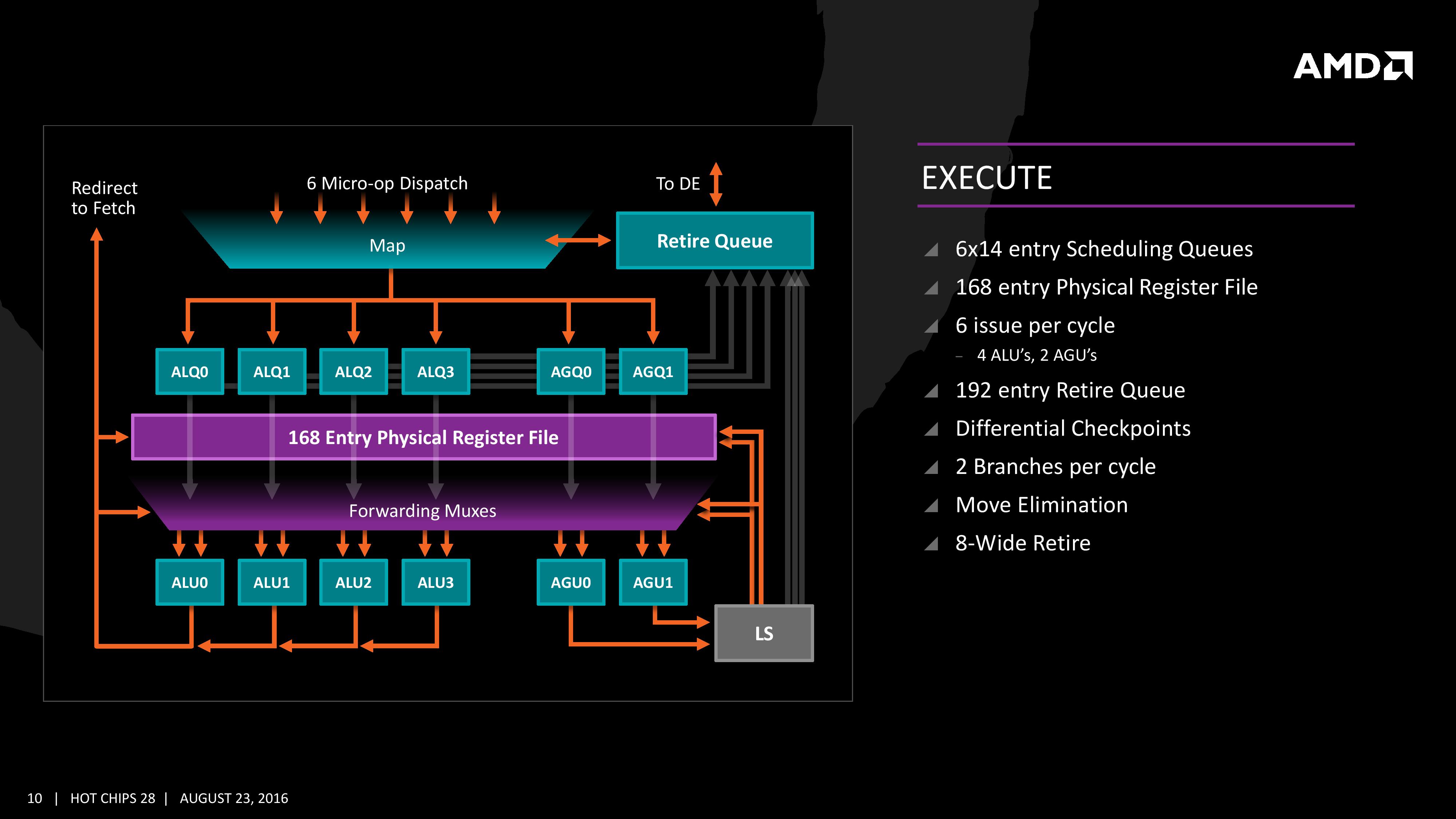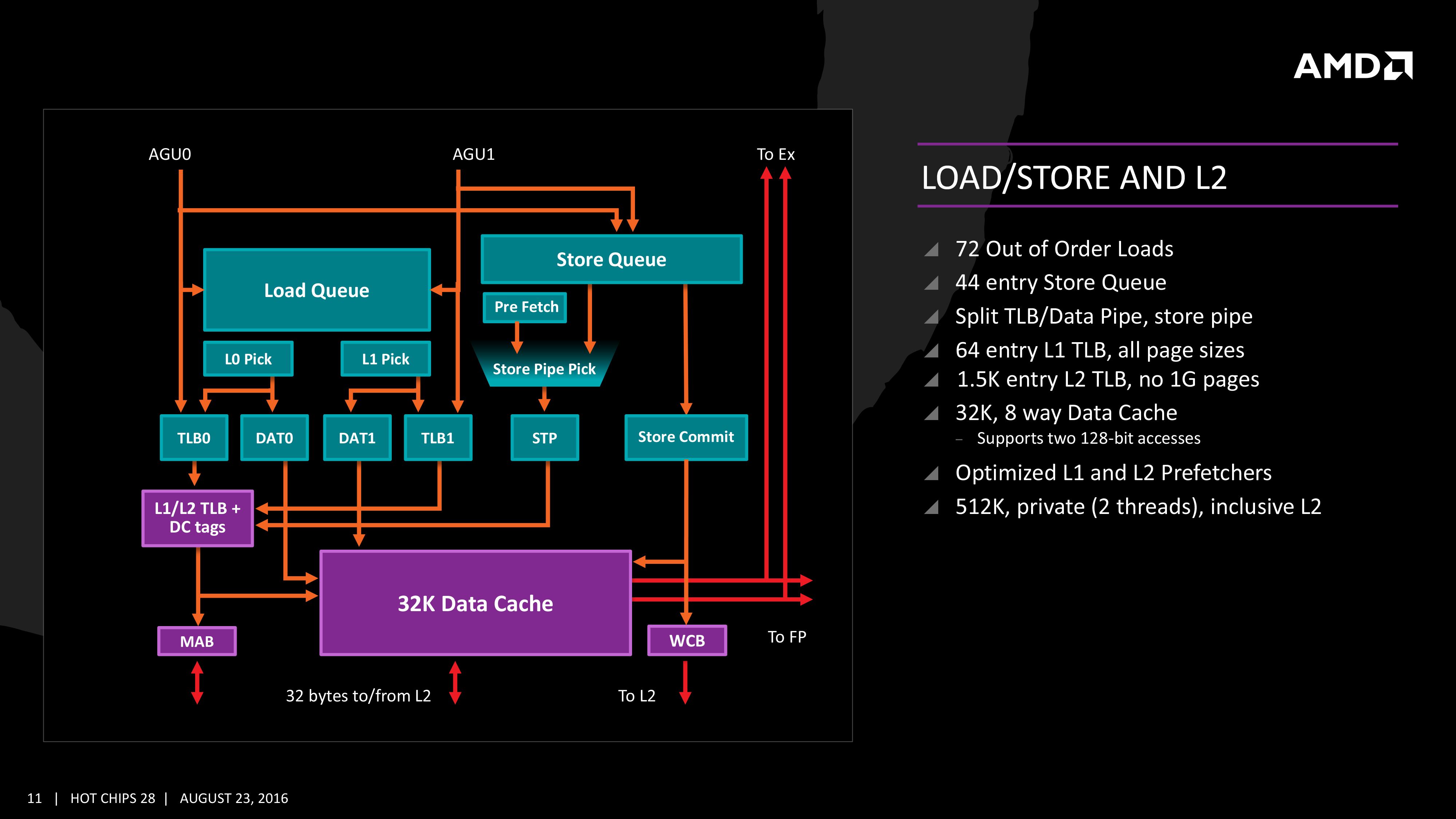AMD Zen Microarchiture Part 2: Extracting Instruction-Level Parallelism
by Ian Cutress on August 23, 2016 8:45 PM EST- Posted in
- CPUs
- AMD
- x86
- Zen
- Microarchitecture
Execution, Load/Store, INT and FP Scheduling
The execution of micro-ops get filters into the Integer (INT) and Floating Point (FP) parts of the core, which each have different pipes and execution ports. First up is the Integer pipe which affords a 168-entry register file which forwards into four arithmetic logic units and two address generation units. This allows the core to schedule six micro-ops/cycle, and each execution port has its own 14-entry schedule queue.
The INT unit can work on two branches per cycle, but it should be noted that not all the ALUs are equal. Only two ALUs are capable of branches, one of the ALUs can perform IMUL operations (signed multiply), and only one can do CRC operations. There are other limitations as well, but broadly we are told that the ALUs are symmetric except for a few focused operations. Exactly what operations will be disclosed closer to the launch date.
The INT pipe will keep track of branching instructions with differential checkpoints, to cut down on storing redundant data between branches (saves queue entries and power), but can also perform Move Elimination. This is where a simple mov command between two registers occurs – instead of inflicting a high energy loop around the core to physically move the single instruction, the core adjusts the pointers to the registers instead and essentially applies a new mapping table, which is a lower power operation.
Both INT and FP units have direct access to the retire queue, which is 192-entry and can retire 8 instructions per cycle. In some previous x86 CPU designs, the retire unit was a limiting factor for extracting peak performance, and so having it retire quicker than dispatch should keep the queue relatively empty and not near the limit.
The Load/Store Units are accessible from both AGUs simultaneously, and will support 72 out-of-order loads. Overall, as mentioned before, the core can perform two 16B loads (2x128-bit) and one 16B store per cycle, with the latter relying on a 44-entry Store queue. The TLB buffer for the L2 cache for already decoded addresses is two level here, with the L1 TLB supporting 64-entry at all page sizes and the L2 TLB going for 1.5K-entry with no 1G pages. The TLB and data pipes are split in this design, which relies on tags to determine if the data is in the cache or to start the data prefetch earlier in the pipeline.
The data cache here also has direct access to the main L2 cache at 32 Bytes/cycle, with the 512 KB 8-way L2 cache being private to the core and inclusive. When data resides back in L1 it can be processed back to either the INT or the FP pipes as required.
Moving onto the floating point part of the core, and the first thing to notice is that there are two scheduling queues here. These are listed as ‘schedulable’ and ‘non-schedulable’ queues with lower power operation when certain micro-ops are in play, but also allows the backup queue to sort out parts of the dispatch in advance via the LDCVT. The register file is 160 entry, with direct FP to INT transfers as required, as well as supporting accelerated recovery on flushes (when data is written to a cache further back in the hierarchy to make room).
The FP Unit uses four pipes rather than three on Excavator, and we are told that the latency in Zen is reduced as well for operations (though more information on this will come at a later date). We have two MUL and two ADD in the FP unit, capable of joining to form two 128-bit FMACs, but not one 256-bit AVX. In order to do AVX, the unit will split the operations accordingly. On the counter side each core will have 2 AES units for cryptography as well as decode support for SSE, AVX1/2, SHA and legacy mmx/x87 compliant code.













106 Comments
View All Comments
tipoo - Wednesday, August 31, 2016 - link
Meanwhile Intel worked on shortening pipelines...Curious to see how this will go, hope for AMDs sake it's competitive.masouth - Friday, September 2, 2016 - link
I hope it works out for AMD as well but reading about long pipelines and higher freqs always reminds me of the P4 days/shudder
junky77 - Wednesday, August 24, 2016 - link
The problem is now having Intel/AMD provide fast enough CPUs to feed the new GPUs that don't seem to slow down..gamerk2 - Wednesday, August 24, 2016 - link
Pretty much anything from an i7 920 onward can keep GPUs fed these days. For gaming purposes, CPUs haven't been the bottleneck for over a decade. That's why you don't see significant improvement from generation to generation, since our favorite CPU tests happen to be with GPU sensitive benchmarks.Death666Angel - Thursday, August 25, 2016 - link
The story is much more complicated than you are making it seem:https://www.youtube.com/watch?v=frNjT5R5XI4
tipoo - Wednesday, August 31, 2016 - link
A Skylake i3 presents better frametimes than old i7s like the 920 or 2500Krhysiam - Wednesday, August 24, 2016 - link
40% over Excavator probably still puts it well behind even Haswell on IPC. If I'm looking at it right, Bench on this site has 4 single threaded tests (3 Cinebench versions and 3D Particle...). I crunched some numbers and found that if you add 40% to Excavator @ 4Ghz (X4 860 turbo), it still loses to Skylake @ 3.9Ghz (turbo) by between 32% & 39% across the four benchmarks. Haswell @ 3.9Ghz (turbo) would still be faster by 24% to 33%.If it really is 40% minimum, AND they can sustain decent clock speeds, then that's at least enough to be in the ballpark, but it's still well short of Intel in those few benchmarks at least. TBH I don't know how representative those benchmarks are of overall single-threaded performance.
It could well be a case of AMD offering significantly poorer lightly threaded performance, but a genuine 8 core CPU at an affordable (i.e. not $1000) price.
gamerk2 - Wednesday, August 24, 2016 - link
I except the following:~40% average IPC gain in FP workloads
~30% average IPC gain in INT workloads
~20% clock speed reduction.
Average performance increase: ~15-20%, or Ivy Bridge i7 level performance.
Michael Bay - Wednesday, August 24, 2016 - link
Well, nothing stops them from their own brand of tick-tock, especially considering largely stagnant intel IPC.looncraz - Wednesday, August 24, 2016 - link
40% over Excavator is almost exactly Haswell overall, particularly once you shape the performance to match what is known about Zen.http://excavator.looncraz.net/